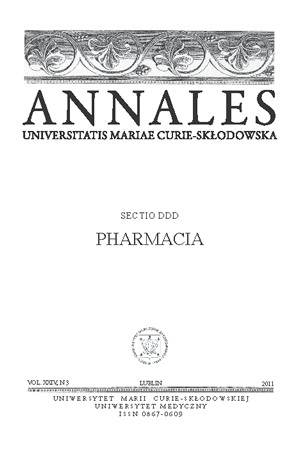Antimicrobial, antioxidant, anticancer property and chemical composition of different parts (corm, stem and leave) of Colocasia esculenta extract
DOI:
https://doi.org/10.12923/Keywords:
antioxidant, anticancer, antimicrobial, chemical compound, Colocasia esculentaAbstract
This study was carried out to reveal antimicrobial, antioxidant and anti-cancer activities of extracts from different parts of Colocasia esculenta namely the corm, stem and leaf. The chemical composition of each part of C. esculenta was also characterized. Antimicrobial property of C. esculenta extracts against Aeromonas hydrophila, Escherichia coli, Edwardsiella tarda, Flavobacterium sp., Klebsiella sp., Salmonella sp., Vibrio alginolyticus, V. parahaemolyticus, V. cholerae and Pseudomonas aeruginosa was revealed by using broth micro-dilution method whereas antioxidant activity of the plant extracts was characterized by using α, α-diphenyl-β-picrylhydrazyl (DPPH) radical scavenging method. Anticancer activity of the extracts was determined with Colorimetric MTT (tetrazolium) assay against human breast adenocarcinoma (MCF-7). Compounds of the plant extracts were screened and identified by using gas chromatography - mass spectrometry (GC-MS). The minimum inhibitory concentration (MIC) values of different parts of C. esculenta extracts ranged from 7.81 to 500 mg/l against the tested bacteria. In terms of antioxidant activity, the inhibition concentration of stem extract of C. esculenta against 50% of DPPH (IC50) was 0.125 ppt whereas IC50 of C. esculenta leaf extract was 0.28 ppt and the IC50 of corm extract was 4.8 ppt. At the concentration of 20 µg/ml and onward, root extract of C. esculenta was found to inhibit 30% of cancer cell growth whereas stem extract of C. esculenta at 30 µg/ml can inhibit 30% of cancer cell growth. On the other hand, no anticancer activity was found in the leaf extract of C. esculenta. A total of 6 compounds were identified in the C. esculenta corm extract with the 8 major compounds, 11-Octadecadienoic acid, methyl ester (54.62%) and Hexadecanoic acid, methyl ester (20.55%) whereas, 12 compounds were successfully identified in C. esculenta stem extract in which Acetic acid 24.70% was the major compound. Eight compounds were identified in the extract of C. esculenta leaf in which Cyclohexanol, 5-methyl-2-(1-methylethyl)-, [1S-(1 α., 2 β, 5 β)]- (54.73%) was the major compound. This study revealed that the potential of C. esculenta to be used as medicinal drug is promising.
References
1. Aniya Y, Miyagi C, Nakandakari A, Kamiya S, Imaizumi N, Ichiba T. 2002. Free radical scavenging action of the medicinal herb Limonium wrightii from the Okinawa islands. Phytomedicine 9 (3): 239-244.
2. Blois MS. 1958. Antioxidant determination by the use of a stable free radical. Nature. 181: 1199-1200.
3. Brand-Williams, W, Cuvelier ME, Berset C. 1995. Use a free radical method to evaluate antioxidant activity. Lebensm. Wiss. Technol. 28: 25-30.
4. Brown AC, Reitzenstein JE, Liu J, Jadus MR. 2005. The anti-cancer effects poi (Colocasia esculenta) on clonic adenocarcinoma cells. Phytotherapy Research 19 (9): 767-771.
5. Gadow A W., Joubert E, Hansmann C F. 1997. Comparison of the antioxidant activity of rooibos tea (Aspalathus linearis) with green, oolong and black tea. Food Chemistry 60 (1): 73-77.
6. Lee SW, Musa N, Chuah TS, Wendy W, Noor Azhar MS. 2008. Antimicrobial properties of tropical plants against 12 pathogenic bacteria isolated from aquatic organisms. African Journal of Biotechnology 7 (13): 2275-2278.
7. Lee SW, Najiah M, Wendy W. 2010. In vitro antimicrobial activities of Colocasia esculenta extract against Vibrio spp. Agricultura 11: 5-7.
8. Lee S W and Najiah M. 2008. Inhibition of Edwardsiella tarda and other fish pathogens by Allium sativum L. (Alliaceae) Extract. American-Eurasian J. Agric. & Environ. Sci. 3 (5): 692-696.
9. Manisha K, Sachin P, Navin S. 2010. Neuropharmacological activity of hydroalcoholic extract of leaves of Colocasia esculenta. Pharmaceutical Biology 48 (11): 1207-1212.
10. Nair R, Kalariya T, Chanda S. Antibacterial Activity of Some Selected Indian Medicinal Flora. J. Biology Turkey 2005;29:41-7.
11. Yen GC, Duh PD. 1994. Scavenging effect of methanolic extracts of peanut hulls on free radical and active oxygen species. J. Agric. Food Chem. 42: 629-632.
Downloads
Published
Issue
Section
License
Copyright (c) 2011 Authors

This work is licensed under a Creative Commons Attribution-NonCommercial-NoDerivatives 3.0 Unported License.


